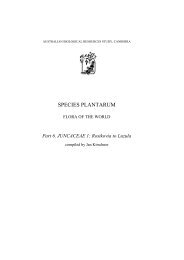Introduction - Species Plantarum Programme
Introduction - Species Plantarum Programme
Introduction - Species Plantarum Programme
Create successful ePaper yourself
Turn your PDF publications into a flip-book with our unique Google optimized e-Paper software.
8<br />
SPECIES PLANTARUM — FLORA OF THE WORLD (1999)<br />
INTRODUCTION<br />
This Guide is based on that of Flora of Australia, and the examples are mainly taken from<br />
that work, modified where necessary. They are intended to illustrate content, style and format<br />
only, and should not be taken to be completely accurate in a world sense (they were<br />
originally written for a continental Flora only). Other examples are completely fictitious. In<br />
cases where particular points are not fully covered by this Guide, then conventions used in<br />
recent volumes of the Flora of Australia will provide an acceptable default standard.<br />
<strong>Species</strong> <strong>Plantarum</strong> — Flora of the World is intended to be a synthesis of present taxonomic<br />
knowledge of the world's flora. Although the treatment of some groups will be based on<br />
recent revisionary studies, it is not intended that the Flora be a monographic work: that<br />
would take much longer to prepare. Rather, the aim is to bring together what is known and in<br />
the process solve the more straightforward problems but not linger over difficult ones. For<br />
many years there will be new discoveries and new problems, and taxonomists will continue<br />
to refine understanding of plant classification.<br />
The Flora will be published in parts of various length, as manuscripts become available.<br />
Ideally, each of these parts will cover a whole family. For large families, a part may comprise<br />
only a subfamily, or in some cases a large genus or group of related genera, but for ease of<br />
reference and cataloguing, excessively small contributions are not encouraged. Authors<br />
intending to submit only part of a family for this series should first discuss this with the<br />
Editorial Committee / Executive Editor, so that attempts can be made to find other authors<br />
prepared to provide complementary accounts to complete major groups.<br />
The Flora is intended for use by professional botanists and any persons requiring<br />
information on the names, characteristics, distribution and habitat of the world's vascular<br />
plants. It should be understandable to anyone with a basic knowledge of plant structures.<br />
While technical terms must often be used they should be restricted as much as possible to<br />
those in common use. Complex and rare terms should be avoided.<br />
The Guide takes the reader through the preparation of a Flora account using examples from<br />
published volumes of Flora of Australia, modified where necessary. It describes the<br />
sequence of the text and explains points of format and style.<br />
Aspects that recur in dealing with family, genus and species are discussed when they first<br />
arise and are then cross-referenced when mentioned later. An index is provided for locating<br />
particular points.<br />
Contributors to the Flora are asked to take particular care not to exceed the recommended<br />
maximum length of descriptions. Longer descriptions will have to be edited down, and it will<br />
save time for the contributor and editorial staff if these are avoided from the start. It must be<br />
kept in mind that the principal aims of a Flora are to enable the reader to identify specimens<br />
and to give a concise, accurate account of the plants of a region.<br />
Contributors, especially those preparing large treatments, are strongly urged to submit a<br />
sample of several descriptions at an early stage. The editorial staff will check and return<br />
these promptly.<br />
Presentation of manuscripts<br />
It is preferred that manuscripts be submitted on disc in electronic form, accompanied by hard<br />
copy. Discs readable directly by an IBM-compatible computer, using most major word<br />
processing packages (Microsoft Word, Word for Windows, WordPerfect, Microsoft Works,<br />
WordStar, etc.) are acceptable. When submitted in this form it is helpful if the text has basic<br />
formatting applied (bold, italic, centring), although unformatted text files are also<br />
acceptable. While Macintosh files can be converted, we prefer DOS-based manuscripts.<br />
If contributors do not have access to computers, or are unable to send electronic copies of<br />
their manuscripts, then typewritten or printed copies of manuscripts can be accepted. All<br />
manuscripts must be typed on one side of A4 (30 cm × 21 cm) bond paper (quarto and US












